Recently Crucial introduced their newest portable SSD, the X6 and at the same time also brought out the new 2TB version of their X8 which I previously took a look at. The X6 is a SATA based drive that was designed with the price in mind which at its 1TB and 2TB capacities bridges the gap between portable hard drives and more expensive NVMe portable drives like the X8. They sent both drives over in the 2TB capacity and when I spoke with them before the launch we talked about the 2TB capacity specifically and why they were focusing on it. For starters, in their research, ¼ of the people looking for external drives are looking for high capacities like this when shopping. Which makes sense really, some people use these to supplement their PC or laptop storage for media downloads and when it comes to digital content creation for storing big video files which take up a lot of space. Those aren’t files you want to wait around at spinning drive speeds waiting to transfer. So today I’m going to take a second look at the X8, now with the new capacity, and check out the new X6 and see how they both perform. Let’s dive in!
Product Names: Crucial X6 2TB and X8 2TB
Review Samples Provided by: Crucial
Written by: Wes Compton
Amazon Affiliate Links: Crucial X6 2TB and Crucial X8 2TB
|
Crucial X6 Specifications |
|
|
Capacities |
1TB and 2TB |
|
Connection |
USB 3.1 Gen-2 Type-C (10Gb/s) |
|
Read Speed |
Up to 540MB/s sequential read |
|
Dimensions |
Length x Width x Height: 0.43 in L x 2.71 in W x 2.52 in H |
|
Weight |
1TB: 39 grams | 1.4 oz 2TB: 42 grams | 1.5 oz |
|
Drop Proof |
Up to 6.5 ft / 2 M on a carpeted concrete floor without impact to data on drive |
|
Warranty |
Manufacturer's 3 Year Limited |
|
Crucial X8 Specifications |
|
|
Capacities |
500GB, 1TB, 2TB |
|
Connection |
USB 3.2 Gen 2 Type-C 10Gb/s |
|
Read Speed |
Up to 1050MB/s sequential read |
|
Dimensions |
110 mm x 11.5 mm x 53 mm |
|
Weight |
1TB: 97 grams 2TB: 101 grams |
|
Drop Proof |
Up to 7.5 ft / 2 M on a carpeted concrete floor without impact to data on drive |
|
Warranty |
Manufacturer's 3 Year Limited |
X6 Photos and Features
Crucial stuck with the same packaging look as they have with the rest of the Crucial lineup which has a dark blue background and a blue glow behind the picture of the drive on the front of the box. I like seeing what is inside before buying, so having the picture on the front is important and I’m glad they include it. The front has the Model name in a readable font down in the bottom left corner with the Crucial logo up in the top left with the blue ribbon. It is weird to me though that they include Crucial in the model name and also have that extra branding. The drive capacity is the largest font on the packaging to make that easy to spot then they also mention an estimated read speed and Windows, Mac, and Android support. Around on the back, there isn’t anything going on, they just have a short description talking about the storage capacity, SSD speeds, and lightweight design that is repeated across 13 languages and they have a link to the support page.


Inside the box, Crucial used a plastic tray to keep the X6 from moving around and to protect it from small impacts. The drive is also wrapped up in plastic to avoid any scratches. Up under the drive they also tucked in a small universal welcome page as well as the USB cable which is a short 6-inch Type-C to Type-C cable. This is an area that Crucial specifically went out of their way to cut costs by not including a Type-A cable or adapter as well but they are going to be selling the X6 with an optional adapter. I was told when buying together it would cost $2.95 more or $9.95 on its own. Not everyone needs a Type-A connection anymore with mobile phones and most laptops having them, that was the idea behind the change at least.


So the X6 has a similar styling as the X8 with the rounded-off corners and smooth shape. The gloss area with the Crucial branding is carried over from the X8 as well. Only the X6 has a plastic housing which they went with to keep costs down but it also means the X6 weighs less. The X6 is also square in overall shape where the X8 is longer. It is about half the size coming in at 2.71” tall and 2.52” wide. It is then .43 of an inch thick but the rounded shape makes that feel even thinner.



This side profile look at the drive gives a better look at what I mean by the rounded edges making the drive feel smaller. Like a phone, it is thickest in the middle but the outside edges are thinner. You can see on the right side of the drive they have the Type-C connection in the middle as well.


So the black plastic housing is mostly covered in a slight texture and if you look closely you can see that it is made of two parts that snap together. The gloss section on the front has the Crucial logo, I think slipping in X6 or the capacity there wouldn’t have been bad. But they did at least do that on the back which also has the same glossy section. Below that there is also a small pad with all of the required certification and warning logos as well as a serial number and model number in the smallest font ever.

 I was curious to see where the X6 came in on the scale and with the plastic housing and small size, it was 42 grams which is extremely lightweight. This is also less than half the weight of the X8 which makes sense given the X8 has a partial metal housing and is twice the size.
I was curious to see where the X6 came in on the scale and with the plastic housing and small size, it was 42 grams which is extremely lightweight. This is also less than half the weight of the X8 which makes sense given the X8 has a partial metal housing and is twice the size.

X8 Photos and Features
The Crucial X8 comes packed up in a package that looks exactly like the last X8 that came in (though the print quality is better this time around) and the same as the X6. This has a dark blue background with a fade behind a picture of the drive in the center. The Crucial logo is up in the corner, highlighted by a light blue box. I think having the actual drive picture on the front is great and is very important. Crucial also makes the drive capacity very clear with it listed in the bottom right corner and also on the top edge as well. Below that they hit at the potential performance with an up to 1050 MB/s section and support for Windows, Mac, PS4, and Xbox One all listed. This is the same list as on our previous X8 but I found it interesting that the X6 focuses on Android rather than PS4 and the XBOX One like the X8. Around on the back, there isn’t much going on. There is a link to support and they repeat the drive speeds across every language you can think of.


Now as far as inside of the box. Well, there is a plastic tray that has the USB cable wrapped up on the bottom. On top of that, the X8 itself comes wrapped in plastic and inside of the tray. Beyond that, there is a small paper folded up as a welcome or startup guide which mostly is filled with the same information repeated in different languages. The cord is the same as with our previous X8 which is a short 6-inch Type-C to Type-C cable (and the same that came with the X6). But the X8 includes the Type-C to Type-A adapter that the X6 skips out on to keep costs low.


Like I mentioned already, I’ve already taken a full look at the X8 and nothing on the exterior has changed at all. Crucial went with a rectangle shape but in the most curved possible way. All of the corners are very rounded and the overall shape has a roundedness as well making all of the edges thin feeling in hand and the thickest part in the middle. The X8 is the same thickness as the X6 at 11.5 mm thick. It is twice as long and the X6 is a little taller with the X8 being 53mm or 2 inches. Like the X6 it has the same glossy accent, only they are longer due to the wider design. The housing on the X8 is made of metal where the X6 is plastic and in hand the difference in the quality felt is huge. The textured finish is the same, but for the X8 with its plastic ends, the ends don’t have the same texture.


The side profile gives a good look at that rounded profile. The X8 has a Type-C connection on the left edge of the drive to hook up to the included cable.



The gloss accents have the branding built-in. On one side, they just have the Crucial logo. Then the other side has Crucial X8 as well as the drive size. On that side they also put all of the required certification logos and warnings as well as a QR code and your serial number should you need to RMA. I like the accent but think the front should have the model name and capacity over just having the Crucial logo, especially with how much space there is.


I did get the X8 on to the scale as well and it's really interesting to compare it with the X6. You can see the metal constructions difference in weight, not to mention the larger size of the X8. It came in at 101 grams where the X6 was 42 grams, less than half.

Performance
For performance testing on both the X6 and the X8 I went through our normal test suite which touches on a few key synthetic benchmarks then I do a few real-world tests to give you a better idea of what you can expect for transfer speeds depending on different file types. Before doing that I did still run CrystalDiskInfo to try to get a peek at what was inside of the drives. It didn’t give me to much information, but it does let me document the firmware revision of both before testing. Besides, I already know what is inside of both drives. With our last X8, I learned that it had a P1 M.2 inside just by going off the firmware revision of the 1TB sample which was P3CR013 and was the same as the P1s firmware update at that time. The P3CR120 of this drive follows the same numbering but is a much later number. This doesn’t line up with the P2 which the firmware started with P2 and P4 so it seems like even with the higher capacity this is still a P1. Which isn’t a bad thing, the P1 is still faster than this USB interface can handle. As for the X6, I was told it is based on the X500 SATA drives, but the size of the drive as well as the firmware (M6CR030) tells us they had to do some work to make things fit in the small size.
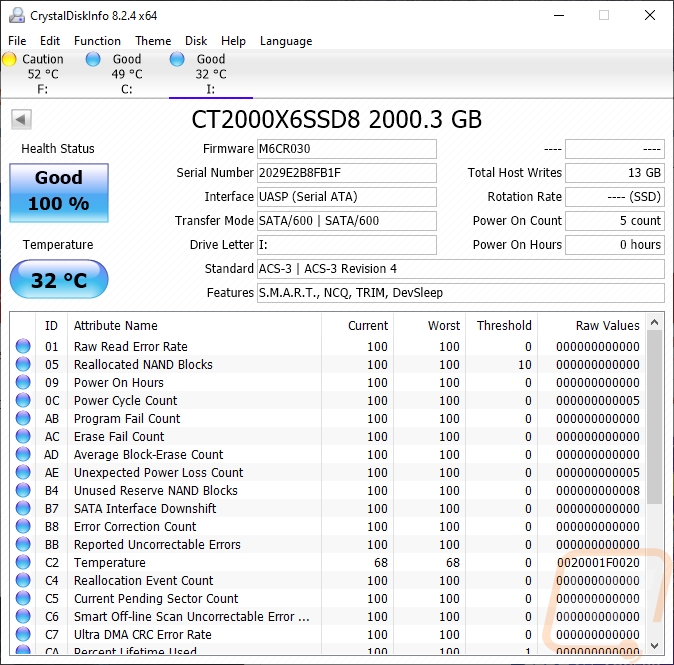
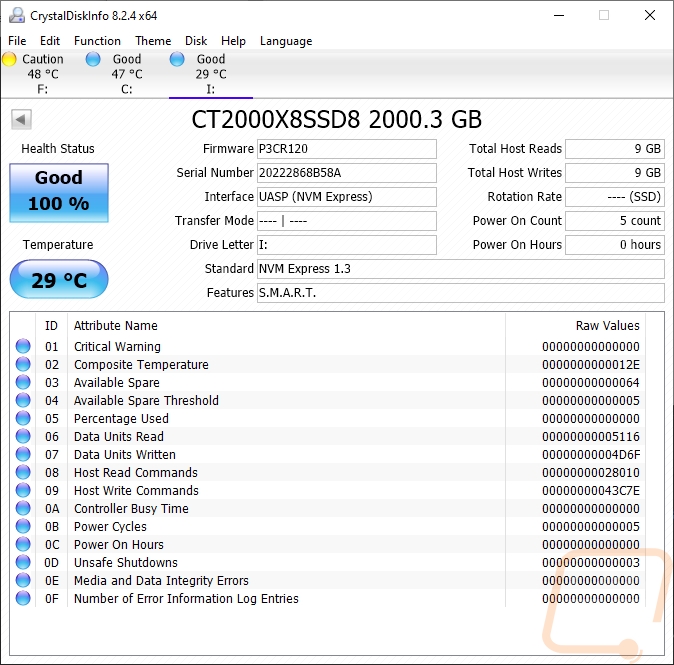
My first tests were in CrystalDiskMark to get a good look at sequential performance mainly. While both do connect through the same interface, you can see a significant performance difference when you are comparing a lower-end NVMe drive against a SATA based drive. Of course, the connection is still the main limitation, our actual P1 pulled twice this in both the read and write speeds. But the X8 is solid right on the upper limits of the normal USB 3.2 Gen 2 which is 1250 MB/s before any overhead. The difference is especially noticeable in the random 4k 32 queue depth and 16 thread test where the X6 is ¼ of the speed on the read but died off on the writes. The controller must get overloaded at those levels. That said, with the pure sequential numbers the X6 still does really well and most importantly is worlds apart from a hard drive based drive (check this one out for example).

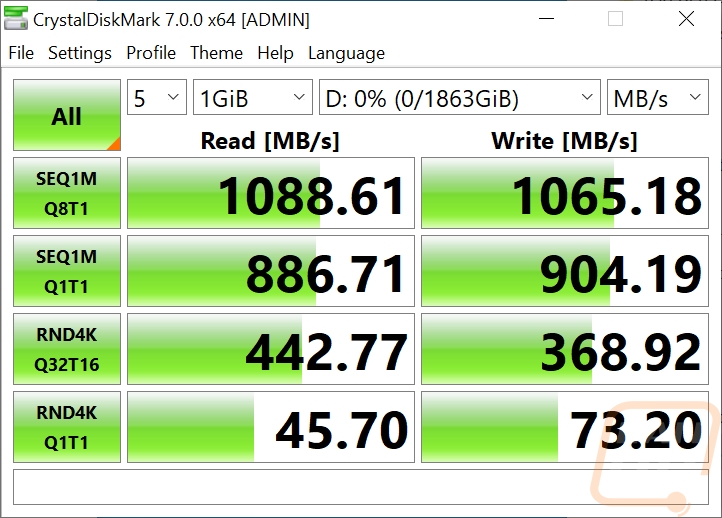
In ATTO Disk benchmark I wanted to get another look at the read and write speeds just to confirm things but I also wanted to check out the IOPS performance. The X8 did exactly what we saw in CrystalDiskMark again, as did the X6 including its write performance being on the lower side compared to the reads. As for the IOPS, the X6 did surprisingly well on the read IOPS but struggled on the writes which the high queue depth CDM test also clued us in on that. The X8 on the other hand didn’t stumble at all with its writes doing very well.
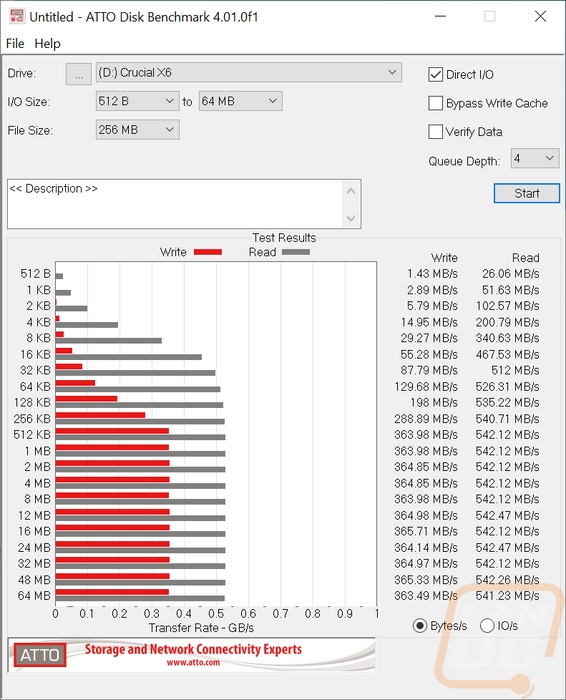
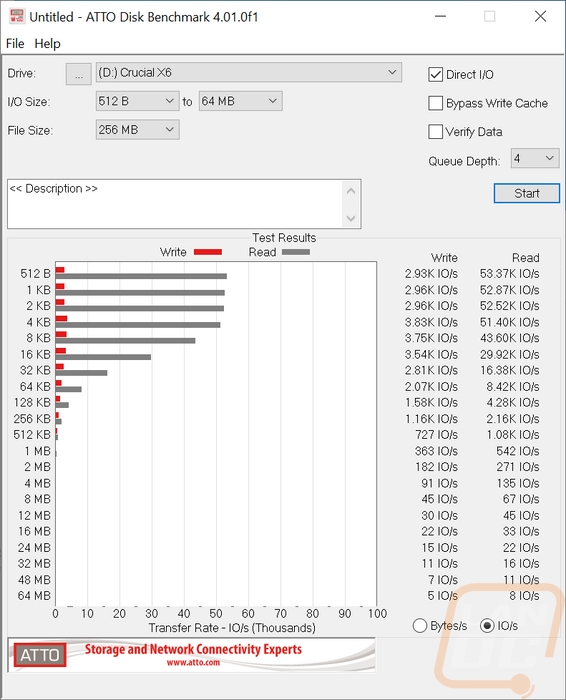
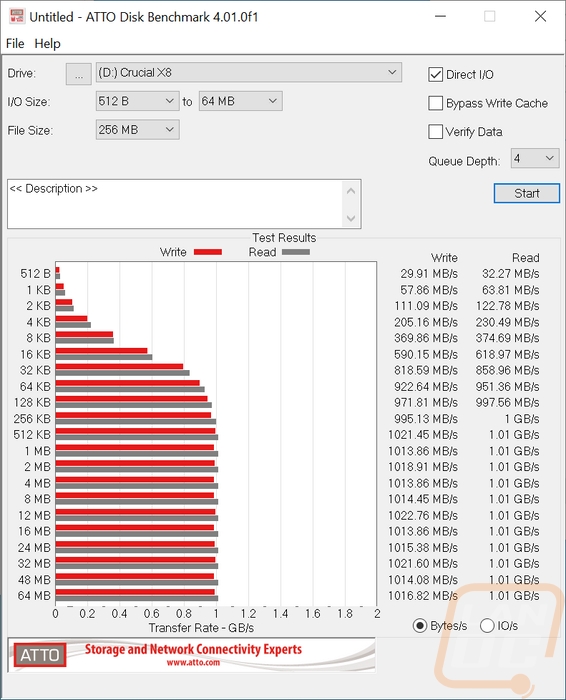

Now Anvils’s Storage Utilities is just a second look at the same thing we saw in CrystalDiskMark as well as the IOPS from ATTO and nothing changed here with the exception of the X6’s IOPS not being as high as ATTO indicated and the X8 doing the opposite and doing even better than ATTO. The X8 rear and write speeds in the sequential tests were a touch lower, down in the mid to low 900’s but still good.
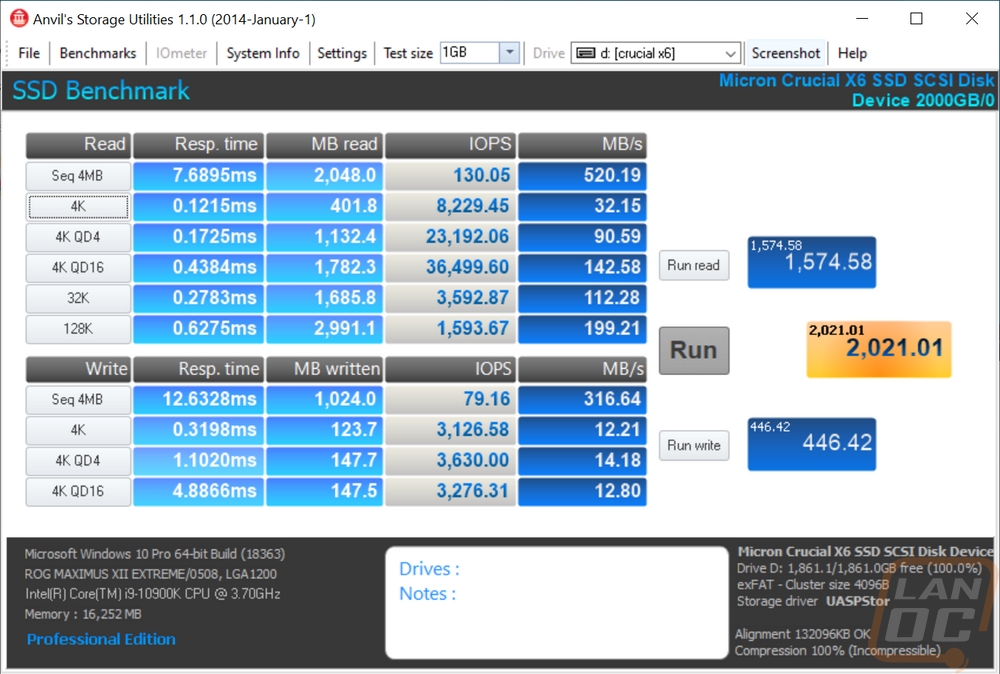
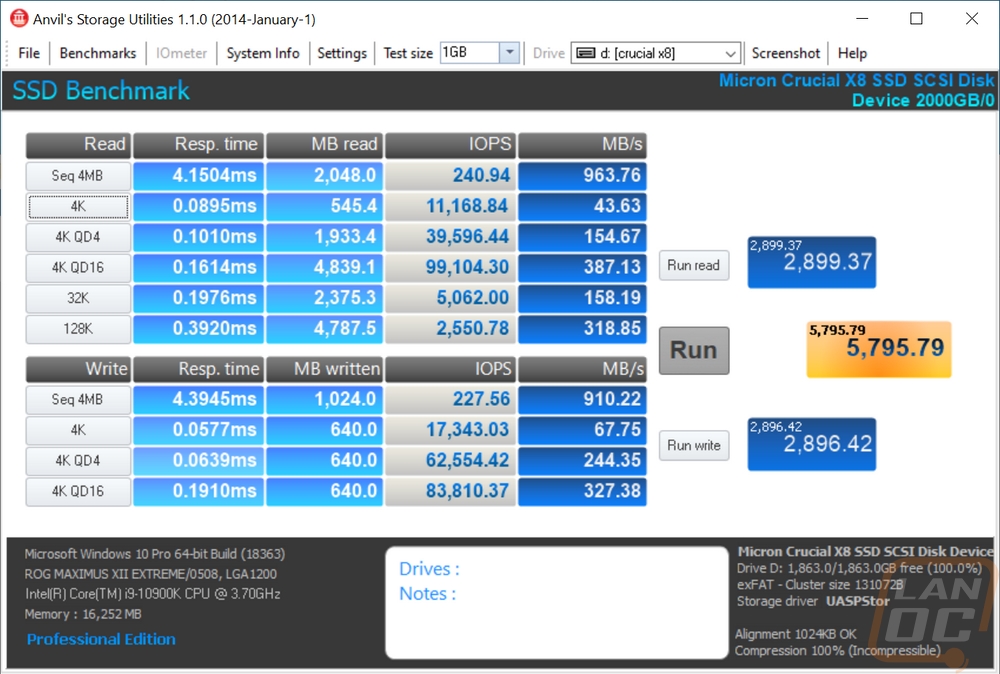
The rest of my testing was focused on actual real-world performance. For this, I split the file types into three types. Large single files, specifically movies. For the middle of the road files I went with pictures, then the last file type was documents that I went with word documents. I then just transferred groups of those files to both the X6 and the X8 to see how they would perform, using real windows transfer speeds as an indication then transferred the same fold of files back on to a fast SSD on the PC doing the same again. All three file types are files that I would expect to see people using their portable drives to backup, travel with, or to transfer files to other devices.


The movie file transfers are the best-case scenario for both of the drives. This is what the sequential speeds in the other tests can relate to as it is one large file, not random files or file sizes. Copying our movies to the drives are write speeds and you can see that with the X6 which transferred at 300MB/s nearly the entire time where the X8 was slower than the synthetic tests at 689 MB/s. They both were faster when copying those same files back to the PC with the X6 sticking right at 496 MB/s the entire time and the X8 was flat as well at 869 MB/s. Both are more than fast enough to move these files around, although the X8 is going to save you a little extra time.
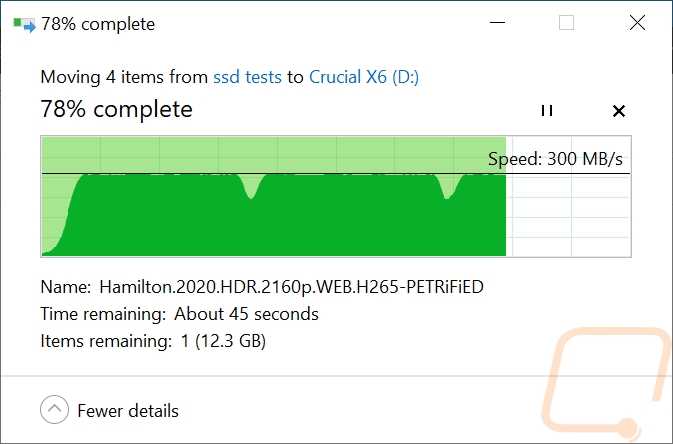
X6 Movies to drive

X8 Movies to drive
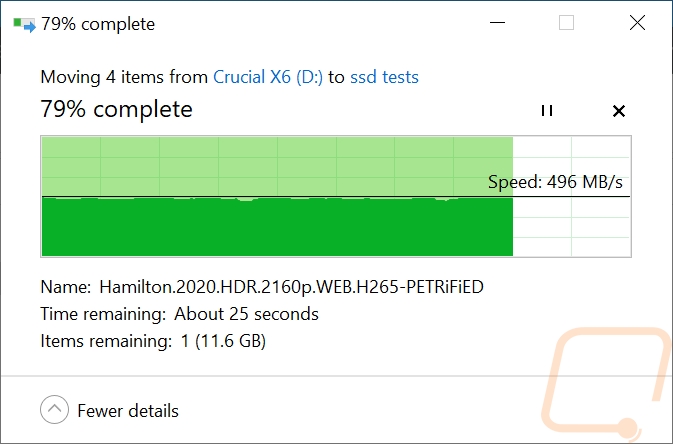
X6 Movies to PC
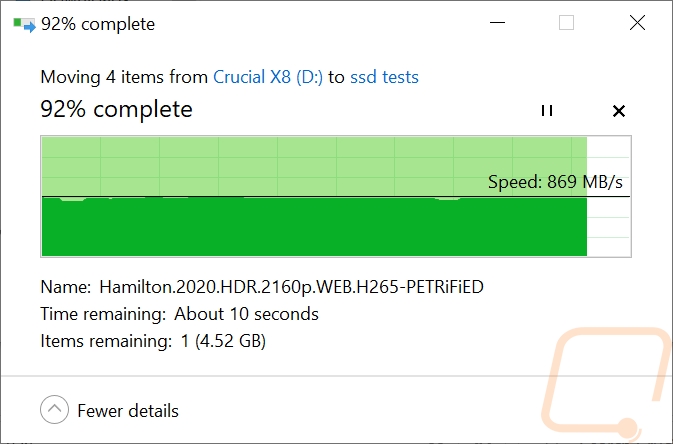
X8 Movies to PC
For pictures, these were just copies of pictures used in my reviews which include RAW, edited, and resized pictures for a variety of file sizes and you can see that a lot in the transfer speeds. Especially on the X6 which was about half the speed of its movie write performance at 143 MB/s at its peak speeds. The X8 did better here at 530 with a lot fewer waves. For the read speeds which are moving back to the PC, the X6 didn’t improve much with its average coming closer to 168 with a few peaks higher. The waves are again visible on it as well. The X8 transferred the files at 644 MB/s which was much faster and again there weren’t as many visible waves.
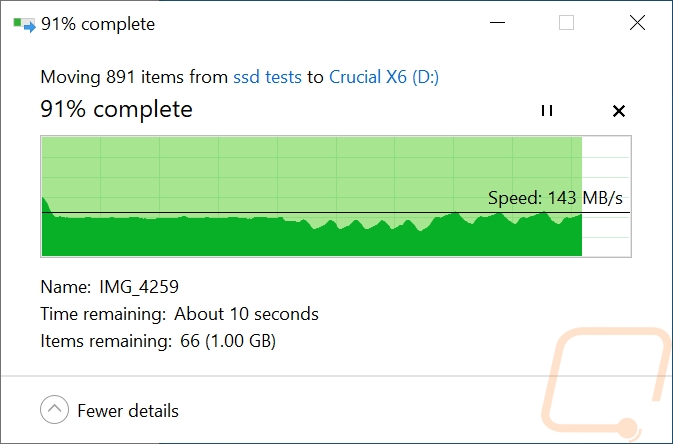
X6 Pictures to drive
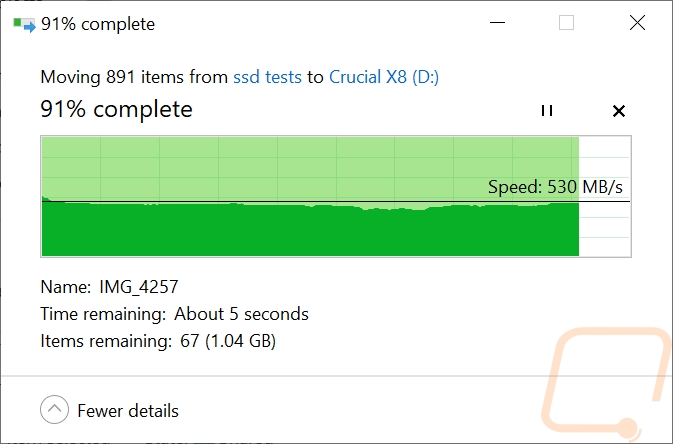
X8 Pictures to drive
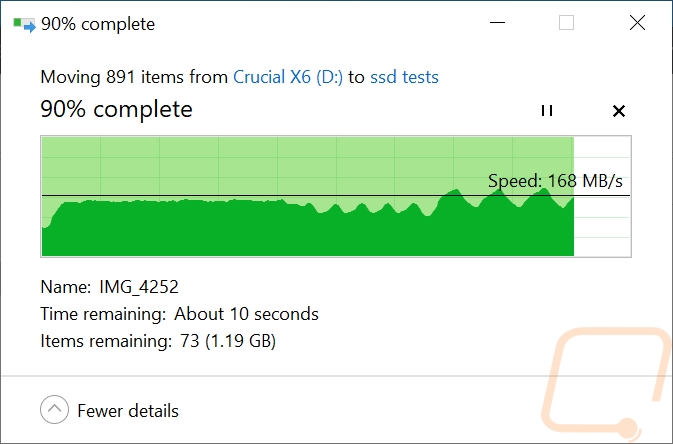
X6 Pictures to PC

X8 Pictures to PC
The last test with the folders filled with Word documents is a lot more demanding on every drive. Even just deleting the generated files after this test is a headache even though their file size is so small. These small files and high quantities of files are what kill transfer speeds, even with the fastest drives. Copying these to the X6 saw a whopping 246 KB/s which is under even a MB/s. The X8 did better but not well at 1.4 MB/s which could be a lot better as well. The last hard drive portable I tested performed similar to the X8 on this type of transfer and I’ve seen other NVMe based drives see around 3-8MB/s. So both drives fall off here, but the X6 is especially slow with this type of load.
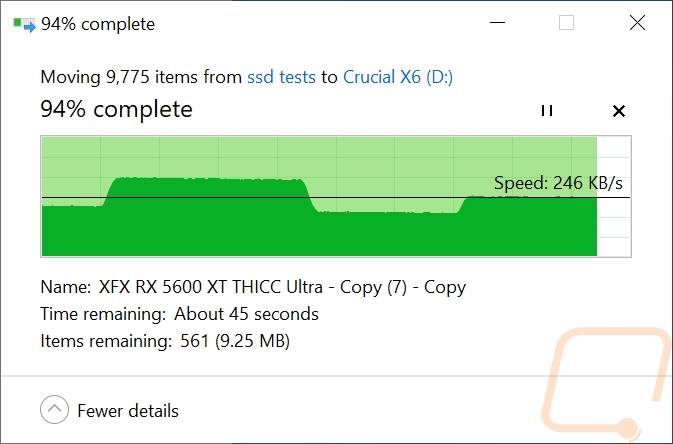
X6 Documents to drive
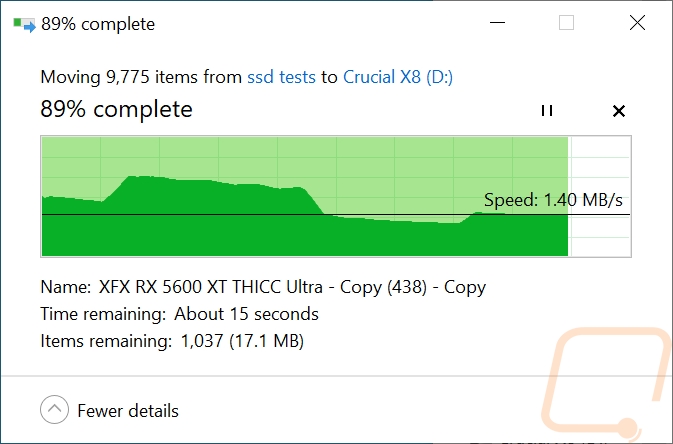
X8 Documents to drive
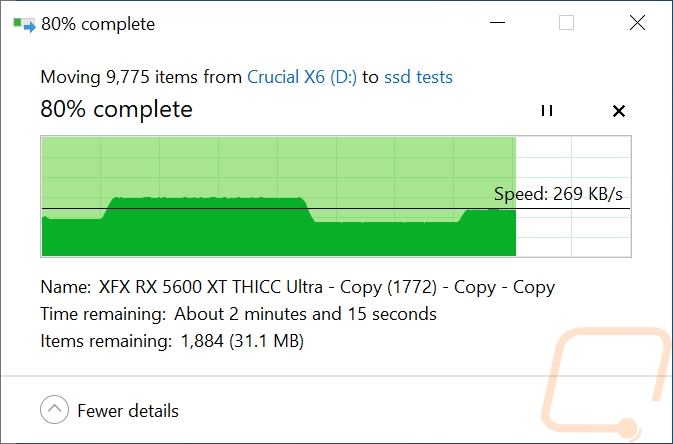
X6 Documents to PC
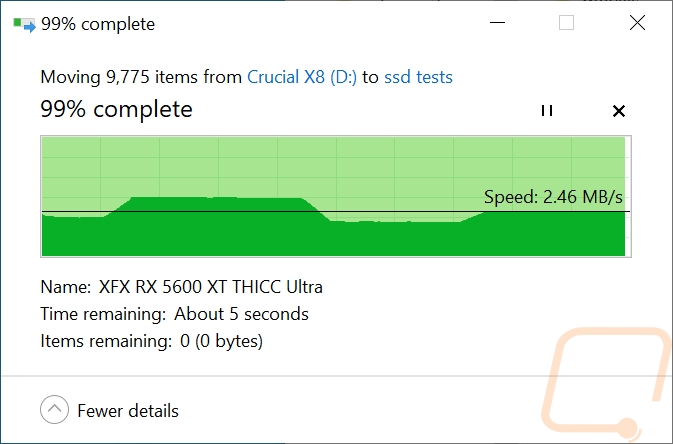
X8 Documents to PC
While doing my testing I did also jump into AIDA64 and used their linear read speed test which I can run for longer periods to do thermal images of both drives after 20+ minute long transfers. Neither drive got too hot. The X8 with its metal casing did a good job of also puling the heat out as well.
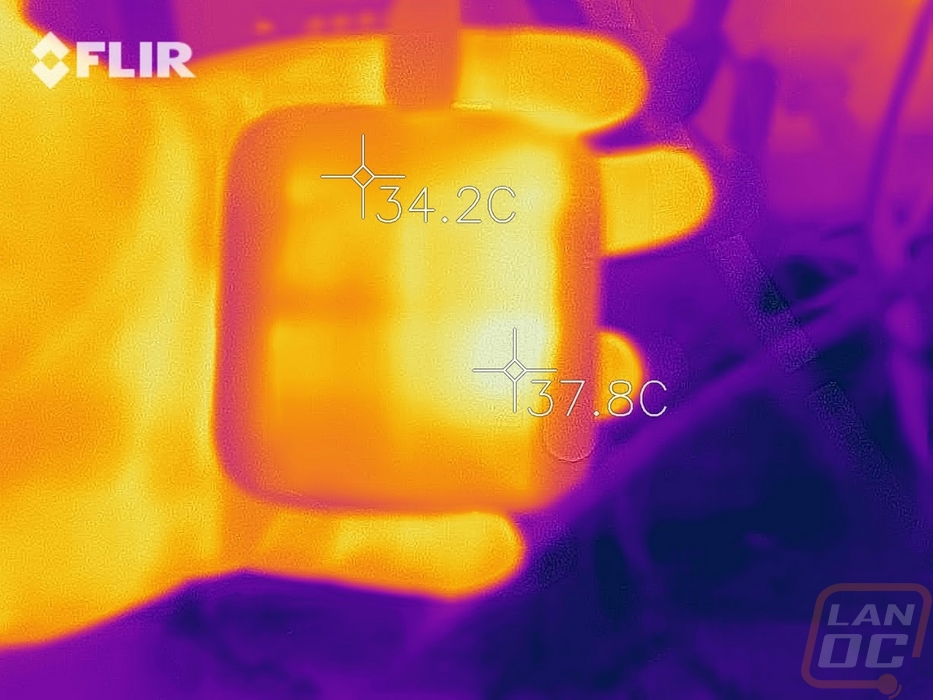
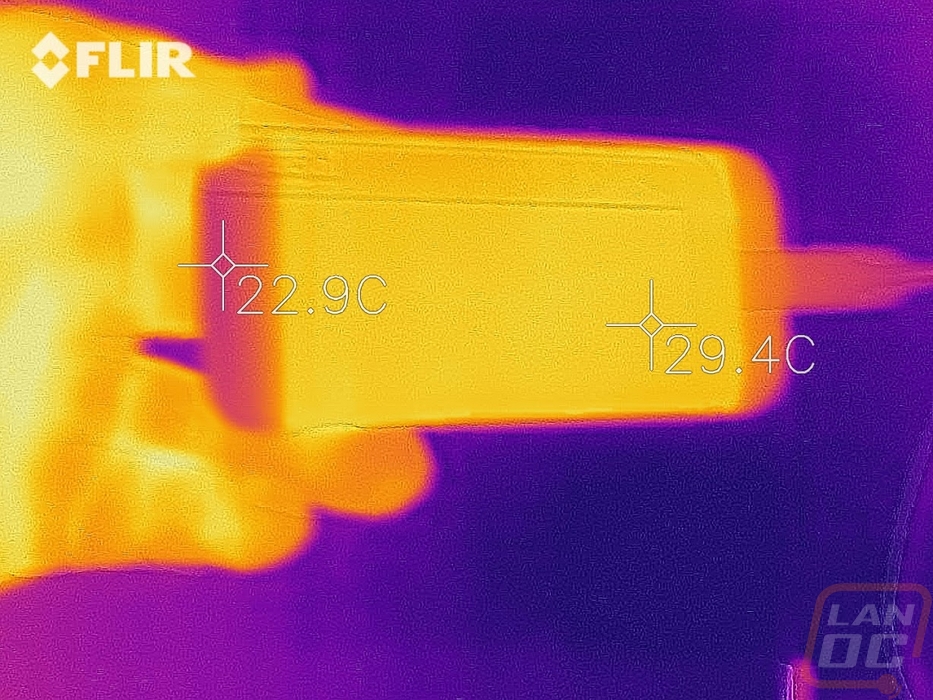
Overall and Final Verdict
I loved the X8 when I first took a look at it so it isn’t a huge surprise that I am still a fan now with the larger 2TB capacity. There are faster drives available when you get into Gen 2x2 and Thunderbolt 3 drives which I have tested both in between my last look at the X8. But when it comes to what everyone has for connection options, the standard USB 3.2 Gen 2 performance is universal and the X8 comes with adapters for both Type-C (which I will always prefer) and Type-A for those types you need it. The X8 still stands out with its aluminum construction which is solid in hand and makes you feel like you could throw it and it wouldn’t hurt it. It also still has that smooth rounded shape that is so easy to toss in your pocket as well, even though the footprint of it is larger than some of the other drives out there.
The X6 is the other hand takes all of the same styling that I like about the X8 but makes it half the size and because this is more of a budget-focused drive it also has a plastic construction that ends up being extremely lightweight. It doesn’t have the X8’s solid feel, but it isn’t too bad of a tradeoff. The X6 goes back to a SATA based drive which performance-wise means about half the sequential transfer speeds. But where it stands out is when you compare it to hard drive based drives where it is going to be 4 times as fast. The X6 accepts that the new NVMe drives are going to be faster, but tries to make up for it in size and pricing. It also is available in the big 2TB capacity just like the X8 which makes it great for competing against the hard drives which also have the same big capacities but take longer to get things on to the drive.
The X6 did have a big downside, its performance when transferring word documents was really bad. The small file size and quantity of files just completely overwhelms the drive. Its write performance overall struggled as well when compared to its read performance. In the cons, I also included a note reminding everyone to get the version that includes the Type-A adapter for a few bucks more if you need it. It isn’t bad that you have the option to get it with or without the adapter, but for a SATA based drive, I can see people using the Type-A often because you won’t see too much of a performance drop from normal USB 3.2 ports.
The X8 has a few downsides as well, but only one is much of a big deal. Its document transfer speeds were also low when compared to other NVMe based drives. Not nearly as bad as the X6, but still a concern if that is the type of file that you plan on mostly moving around. Beyond that, I just mentioned that some similar drives have a smaller footprint, though I think the rounded shape of the X8 is still easier to carry about.
Now for pricing, rather than trying to list them all out, I put together a table below. There were a few things that stood out to me.
|
Amazon Prices |
Crucial X6 |
Crucial X6 W/Adapter |
Crucial X8 |
|
1TB |
$154.95 |
N/A |
$148.95 |
|
2TB |
$264.95 |
$274.94 |
$329.99 |
For starters, the adapter model of the X6 on Amazon isn’t even available in the 1TB model and at 2TB the price difference is huge right now with it costing $10 more. Which doesn’t line up with the pricing Crucial is trying to sell them on their website. Making that adapter way too expensive. Another big standout is the 1TB prices between the X6 and X8. The X8 is $6 LESS than the X6 right now making it a no brainer given its aluminum housing and faster speeds, not to mention it includes the adapter. Seriously, check it out and use my affiliate link while you are at it lol. The pricing at 2TB makes more sense and the $65 discount going from the X8 to the X6 makes sense if you don’t need the raw performance as much but still need the capacity. At the 2TB capacity which is what I tested out today the pricing is more in line with the market. The X6 is cheaper than similar drives like the SanDisk Extreme which is $289 an the Samsung T5 at $276. The X8 ends up being a touch higher than the Samsung T7 which is $319 but lower than the SanDisk Extreme Pro which is $329 making it middle of the road.
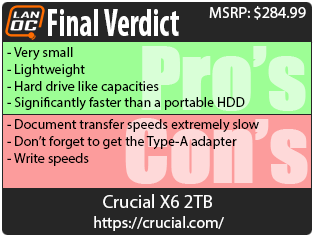

Live Pricing: HERE
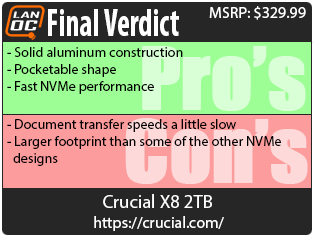

Live Pricing: HERE




